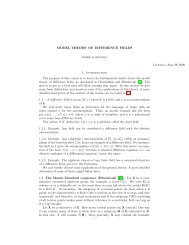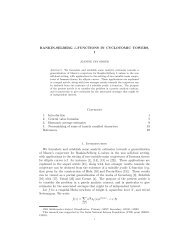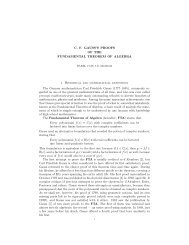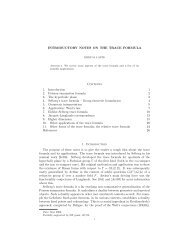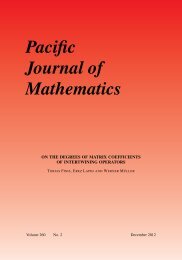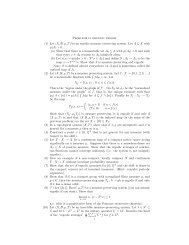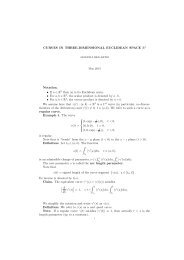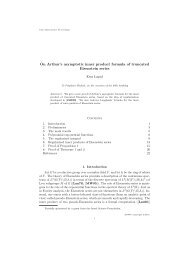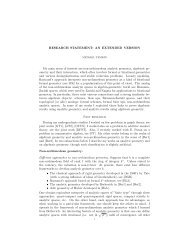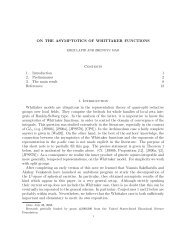The error rate of learning halfspaces using kernel-SVM
The error rate of learning halfspaces using kernel-SVM
The error rate of learning halfspaces using kernel-SVM
You also want an ePaper? Increase the reach of your titles
YUMPU automatically turns print PDFs into web optimized ePapers that Google loves.
Consequently, every approximated solution to the Program with an additive <strong>error</strong> <strong>of</strong> at mostγ will have a 0-1 loss bounded by Err γ (D) + 2γ.For every γ, define a 1-Lipschitz convex surrogate by{1 − x x ≤ 1/C(γ)l γ (x) =1 − 1/C(γ) x ≥ 1/C(γ)Claim 1 A function g : B → R is a solutions to Program (5) with l = l γ , C = 1 and theembedding ψ, if and only if C(γ) · g is a solutions to Program (2) with C = C(γ) and theembedding ψ.We postpone the pro<strong>of</strong> to the end <strong>of</strong> the section. We note that Program (5) with l = l γ ,C = 1 and the embedding ψ, have a complexity <strong>of</strong> 1, according to our conventions. Moreover,by Claim 1, the optimal solution to it has a 0-1 <strong>error</strong> <strong>of</strong> at most Err γ (D) + γ. Thus, if A isan algorithm that is only obligated to return an approximated solution to Program (5) withl = l γ , C = 1 and the embedding ψ, we cannot lower bound its approximation ratio. Inparticular, our <strong>The</strong>orems regarding the approximation ratio are no longer true, as currentlystated, if the algorithms are allowed to choose the surrogate according to γ. One might betempted to think that by the above construction (i.e. taking ψ as our embedding, choosingC = 1 and l = l γ , and approximate the program upon a sample <strong>of</strong> size poly(1/γ)), we haveactually gave 1-approximation algorithm. <strong>The</strong> crux <strong>of</strong> the matter is that algorithms thatapproximate the program according to a finite sample <strong>of</strong> size poly(1/γ) are only guaranteedto find a solution with an additive <strong>error</strong> <strong>of</strong> poly(γ). For the loss l γ , such an additive <strong>error</strong>is meaningless: Since for every function f, Err D,lγ (f) ≥ 1 − 1/C(γ), the 0 solution has anadditive <strong>error</strong> <strong>of</strong> poly(γ). <strong>The</strong>refore, we cannot argue that the solution returned by thealgorithm will have a small 0-1 <strong>error</strong>. Indeed we anticipate that the algorithm we havedescribed will suffer from serious over-fitting.To summarize, we note that the lower bounds we have proved, relies on the fact that theoptimal solutions <strong>of</strong> the programs we considered are very bad. For the algorithm we sketchedabove, the optimal solution is very good. However, guaranties on approximated solutionsobtained from a polynomial sample are meaningless. We conclude that lower bounds forsuch algorithms will have to involve over-fitting arguments, which are out <strong>of</strong> the scope <strong>of</strong> thepaper.Pro<strong>of</strong> (<strong>of</strong> claim 1) Define{1 − C(γ)x x ≤1lγ(x) ∗ C(γ)=0 x ≥ 1C(γ)Since lγ(x) ∗ = C(γ) · (l γ (x) − (1 − 1 )), it follows that the solutions to Program (5) withC(γ)l = lγ, ∗ C = 1 and ψ coincide with the solutions with l = l γ , C = 1 and ψ. Now, we notethat, for every function f : B → R,Err D,l ∗ γ(f) = Err D,hinge (C(γ) · f)Thus, w, b minimizes Err D,l ∗ γ(Λ w,b ◦ ψ) under the restriction that ‖w‖ ≤ 1 if and only ifC(γ) · w, C(γ) · b minimizes Err D,hinge (Λ w,b ◦ ψ) under the restriction that ‖w‖ ≤ C(γ).42✷




